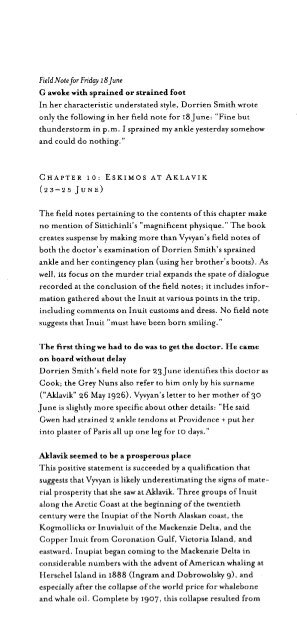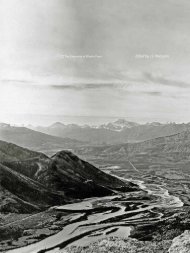C Ihe Ladies c cu. V'VVAN - History and Classics, Department of
C Ihe Ladies c cu. V'VVAN - History and Classics, Department of
C Ihe Ladies c cu. V'VVAN - History and Classics, Department of
- No tags were found...
Create successful ePaper yourself
Turn your PDF publications into a flip-book with our unique Google optimized e-Paper software.
Notes to Pages 53.207 259Field Note for FridC!)' 18 JuneG awoke with sprained or strained footIn her characteristic understated style, Dorrien Smith wroteonly the following in her field note for 18June: "Fine butthunderstorm in p.m. I sprained my ankle yesterday somehow<strong>and</strong> could do nothing."CHAPTER 10: ESKIMOS AT AKLAVIK(23-25 JUNE)The field notes pertaining to the contents <strong>of</strong> this chapter makeno mention <strong>of</strong> Sittichinli's "magnificent physique." The bookcreates suspense by making more than Vyvyan' s field notes <strong>of</strong>both the doctor's examination <strong>of</strong> Dorrien Smith's sprainedankle <strong>and</strong> her contingency plan (using her brother's boots). Aswell, its fo<strong>cu</strong>s on the murder trial exp<strong>and</strong>s the spate <strong>of</strong> dialoguerecorded at the conclusion <strong>of</strong> the field notes; it includes informationgathered about the Inuit at various points in the trip,including comments on Inuit <strong>cu</strong>stoms <strong>and</strong> dress. No field notesuggests that Inuit "must have been born smiling."The first thing we had to do was to get the doctor. He callleon board without delayDorrien Smith's field note for 23June identifies this doctor asCook; the Grey Nuns also refer to him only by his surname("Aklavik" 26 May 1926). Vyvyan's letter to her mother <strong>of</strong> 30June is slightly more specific about other details: "He saidGwen had strained 2 ankle tendons at Providence + put herinto plaster <strong>of</strong> Paris all up one leg for 10 days."Aklavik seemed to be a prosperous placeThis positive statement is succeeded by a qualification thatsuggests that Vyvyan is likely underestimating the signs <strong>of</strong> materialprosperity that she saw at Aklavik. Three groups <strong>of</strong> Inuitalong the Arctic Coast at the beginning <strong>of</strong> the twentiethcentury were the Inupiat <strong>of</strong> the North Alaskan coast, theKogmollicks or Inuvialuit <strong>of</strong>the Mackenzie Delta, <strong>and</strong> theCopper Inuit from Coronation Gulf, Victoria Isl<strong>and</strong>, <strong>and</strong>eastward. Inupiat began coming to the Mackenzie Delta inconsiderable numbers with the advent <strong>of</strong> American whaling atHerschel Isl<strong>and</strong> in 1888 (Ingram <strong>and</strong> Dobrowolsky 9), <strong>and</strong>especially after the collapse <strong>of</strong> the world price for whalebone<strong>and</strong> whale oil. Complete by 19°7, this collapse resulted fromthe invention <strong>of</strong> artificial whalebone, steel springs, <strong>and</strong>kerosene. By 1924, fully seventy-five per cent <strong>of</strong>Inuit in theDelta were considered to be <strong>of</strong> Alaskan origin (Usher 1:25).The immigrant population continued to increase:The native Mackenzie Eskimos had never lived permanentlyin the wooded country <strong>of</strong> the Delta, <strong>and</strong> remained largelyon the coast. The Delta people ... which consisted largely <strong>of</strong>the Alaskan immigrants ... were therefore the ablest <strong>and</strong>most energetic trappers, <strong>and</strong> indeed the most recent immigrantshad come mainly for that purpose .... By the early1920s the value <strong>of</strong> both muskrat <strong>and</strong> white fox hadincreased twentyfold since the turn <strong>of</strong>the century, <strong>and</strong> theprice <strong>of</strong> other furs had risen in similar fashion. Muskratswere taken by the hundred thous<strong>and</strong>s, <strong>and</strong> mink was also abig crop in the Delta. Traders realized excellent pr<strong>of</strong>its,<strong>and</strong> the Delta trappers attained unprecedented prosperity;indeed many had far greater incomes than the averageCanadian at the time. Although much <strong>of</strong> their money wasdissipated in ephemeral luxuries, the Eskimos began toinvest considerable sums in capital equipment. Gaspowered whaleboats <strong>and</strong> schooners were the most popularitems. In 1924 the Eskimo fleet at Aklavik consisted <strong>of</strong> 39schooners (19 <strong>of</strong> which had auxiliary power), 28 whale boats<strong>and</strong> two other vessels .... The Alaskan Eskimos were interestedin producing a cash crop in order to amass wealthbeyond the daily needs <strong>of</strong> shelter <strong>and</strong> food, <strong>and</strong> were willing<strong>and</strong> able to employ superior technology, greater commercialsophistication <strong>and</strong> increased geographical mobility todo so. The Mackenzie people resented these attitudes, <strong>and</strong>the distinction between the two groups on this basispersisted for at least fifty years after the initial immigration.Indeed, it continues today [1970] in modified form.(Usher 1:28,3°)Kitto's "Report" <strong>of</strong> 1920 corroborates thisview-"a layman isstruck with two main thoughts, i.e. (1) that the Indian populationhas lost its vitality <strong>and</strong> the race in consequence is graduallydying out, <strong>and</strong> (2) that the Esquimo [sic] population on theother h<strong>and</strong> appears to be quite vigorous <strong>and</strong> healthy" (27)-<strong>and</strong>Knud Rasmussen's eyewitness account in the early months <strong>of</strong>1924 echoes it: "the Mackenzie Eskimos had become an independent<strong>and</strong> prosperous people" (Ostermann 52). Six groupscomprise the Mackenzie Delta Inuvialuit today: Kigirktayuk
















